Introduction:
Internet Explorer 11 will no longer be supported after June 15, 2022. Microsoft says in its blog that “After 25+ years of helping people use and experience the web, Internet Explorer (IE) is officially retired and out of support as of today, June 15, 2022.”
They recommend switching all users to the Microsoft Edge browser. Also, the Microsoft blog says, “After being retired on June 15, 2022, the Internet Explorer desktop application will be disabled and out of support, automatically redirecting users to Microsoft Edge when launched.”
The Microsoft 365 admin center provides a way to block the use of legacy web apps in Internet Explorer in your organization and provides a set of instructions that will help you move those users over to Microsoft Edge with IE mode.
This blog provides an overview of the setup instructions using the Microsoft 365 admin center.
Login to the Microsoft 365 admin center with your Global Administrator account or equivalent administrator account. In the navigation menu, choose Setup → Block use of Internet Explorer in your organization. This will open a Getting Started page as shown in the below image.
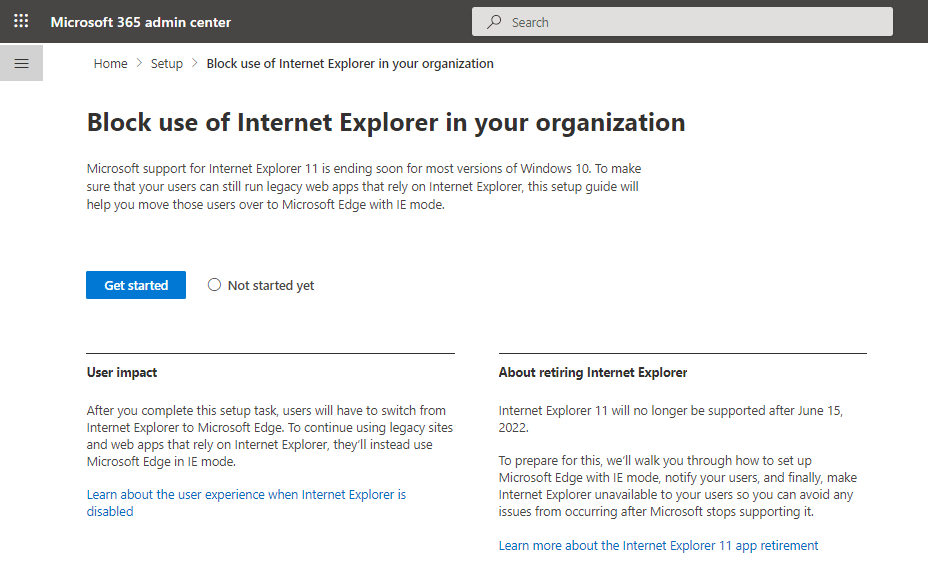
User impact: After completing this setup task, users will have to switch from Internet Explorer to Microsoft Edge. To continue using legacy sites and web apps that rely on Internet Explorer, they’ll instead use Microsoft Edge in IE mode.
Click the button “Get started” to proceed to the setup.
Step 1: Identify how many users are still using Internet Explorer 11 in your organization
With the Microsoft browser usage report in the Microsoft 365 admin center, you can see who has used Internet Explorer to access Microsoft 365 online services. You can send emails to those users to let them know that they must move to Microsoft Edge before June 15, 2022.
Clicking the link “View browser usage in this page” provides information about active users using the Internet Explorer browser to access Microsoft 365 applications. The below screenshot shows an example of these details.
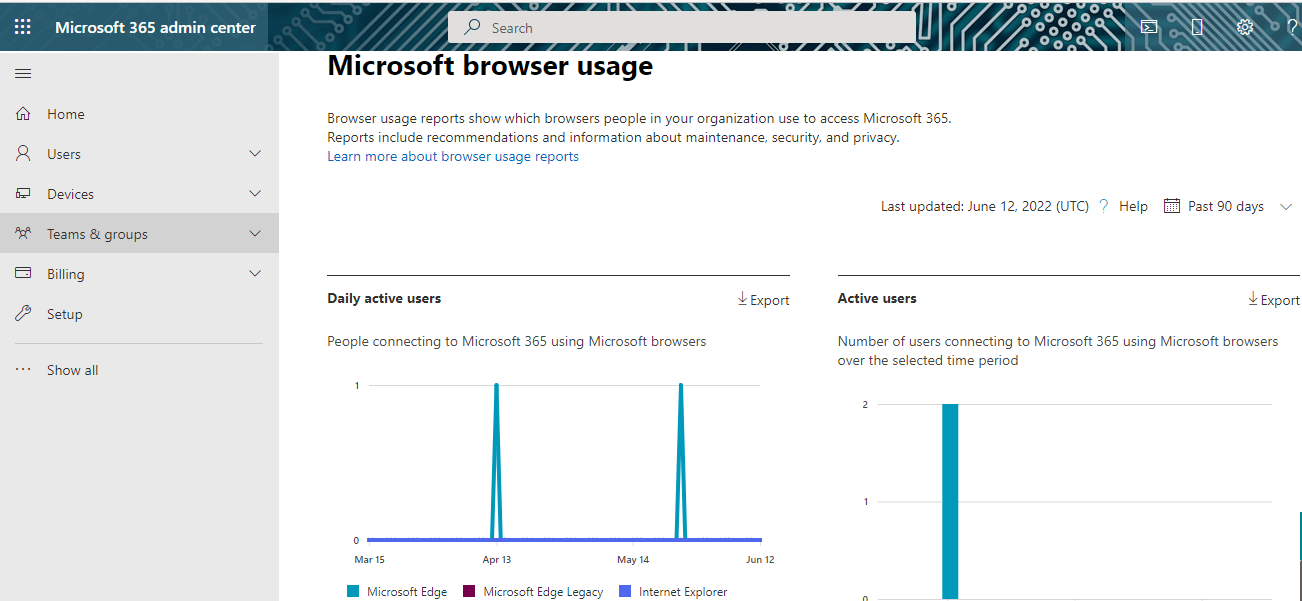
Click Next on the main page to proceed further.
Step 2: Addressing Internet Explorer dependencies
In this step, we are setting up IE mode in Microsoft Edge to maintain access to the users. This helps if your organization has legacy applications or site dependencies that require Internet Explorer.
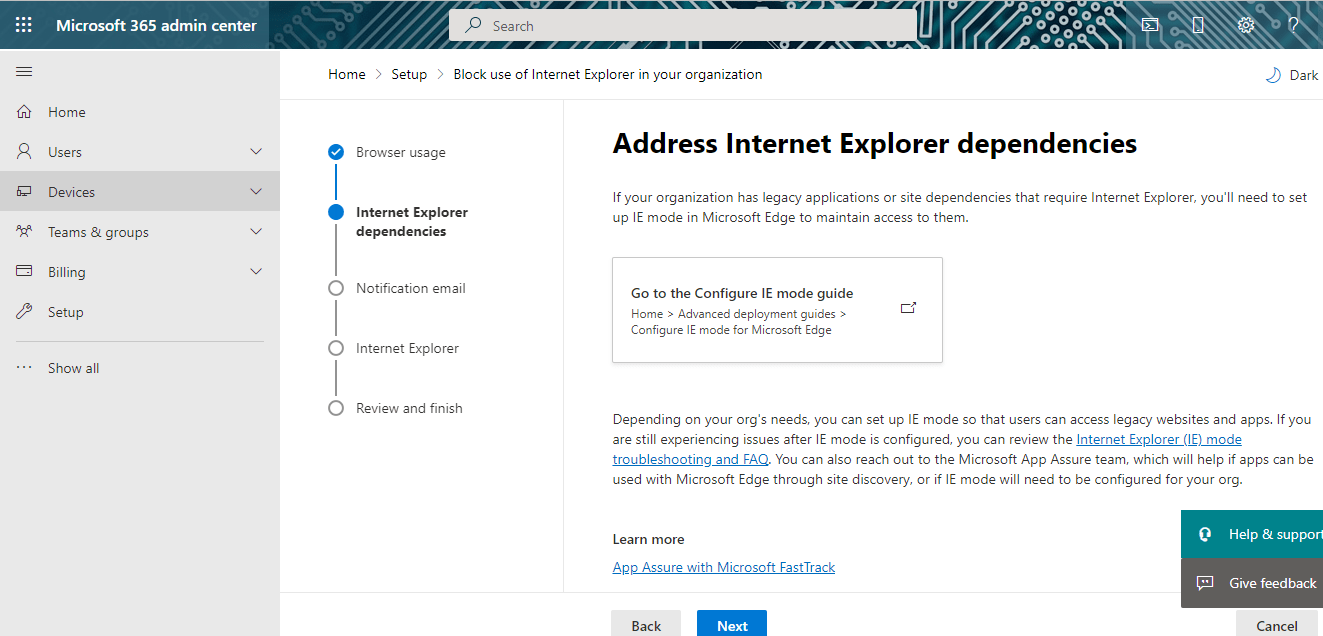
Click the menu “Go to the Configure IE mode guide” to proceed to setup IE mode in the Microsoft Edge browser.
In this section, you are providing the site list of the users whose IE mode is to be configured in their Microsoft Edge browser. Here we have a list of users who often use Microsoft 365 apps in IE.
In the next step, we have to choose the deployment method to manage the Windows devices, i.e., you can choose either the Windows Intune or Group Policy methods. Here we are choosing the option “Apply my completed site list of users“ and the deployment method as “Group policy”.
Note: You can use Group Policy to configure policy settings for Microsoft Edge and manage Microsoft Edge updates on all versions of Windows
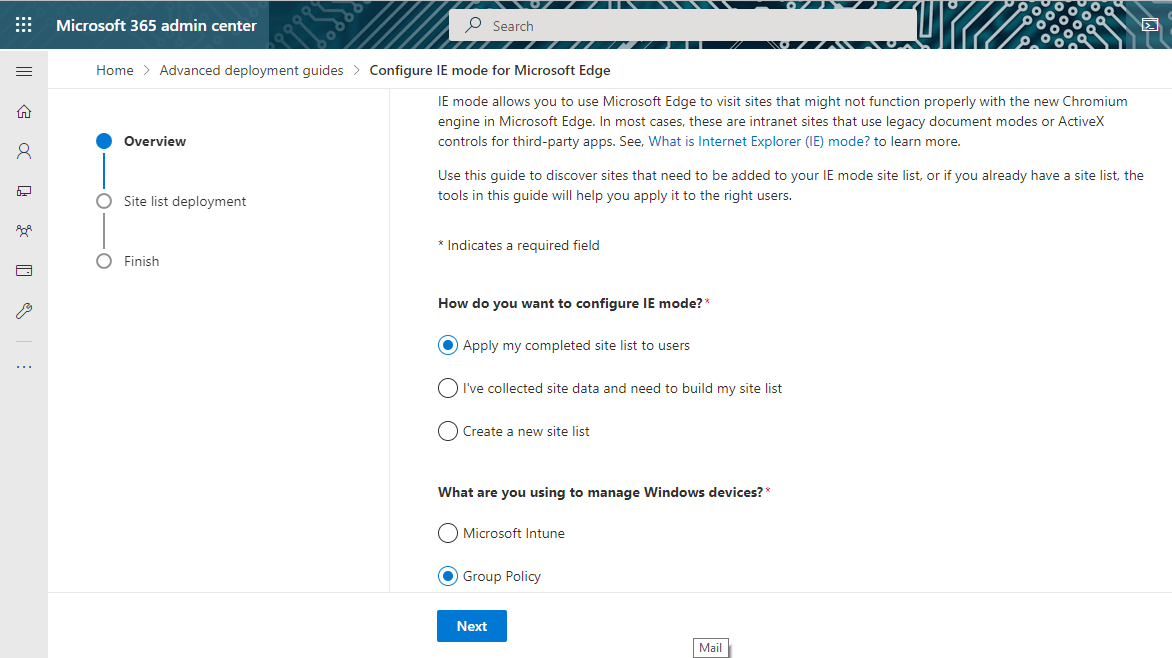
Click “Next” to continue.
You can use the PowerShell script to automatically configure the IE mode and Enterprise Mode Site List path policy settings. Below, screenshots show these details.
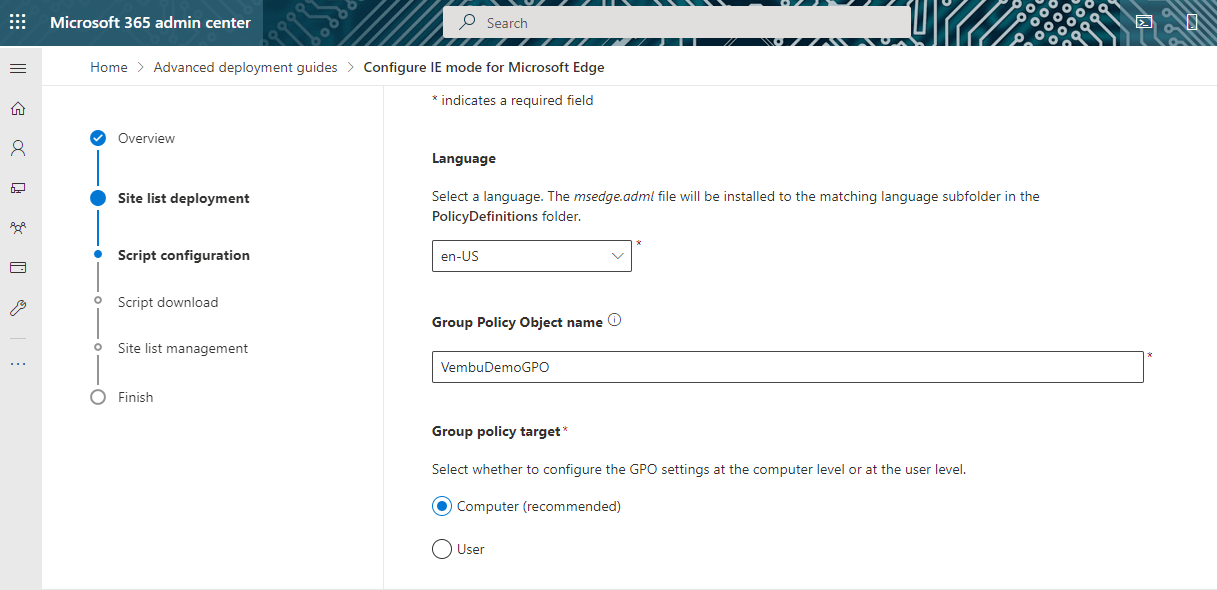
Enable the check box “Use a script to configure IE mode in Microsoft Edge”
Select a Language. Here it is in en-US.
Provide a name for the Group Policy Object, and choose “Computer” as the Group policy target.
In the Configure Internet Explorer integration section, choose IE mode.
You can configure Internet Explorer to open directly within Microsoft Edge (IE mode). The IE mode on Microsoft Edge makes it easy to use all the sites your organization needs in a single browser.
Also, the user has to choose the site list he created, either OnPremise or Cloud. Once all the configurations are done, you will be able to download the PowerShell script.
Step 3: Edit and preview the email
In this step, you can send a notification to your users letting them know when Internet Explorer will be blocked in your organization and providing steps for your users to move to Microsoft Edge seamlessly. You can select the users that appear on the browser usage report. You can also add a message, which is optional.
You can see an email preview as shown in the below screenshot, which will be sent to the recipients.
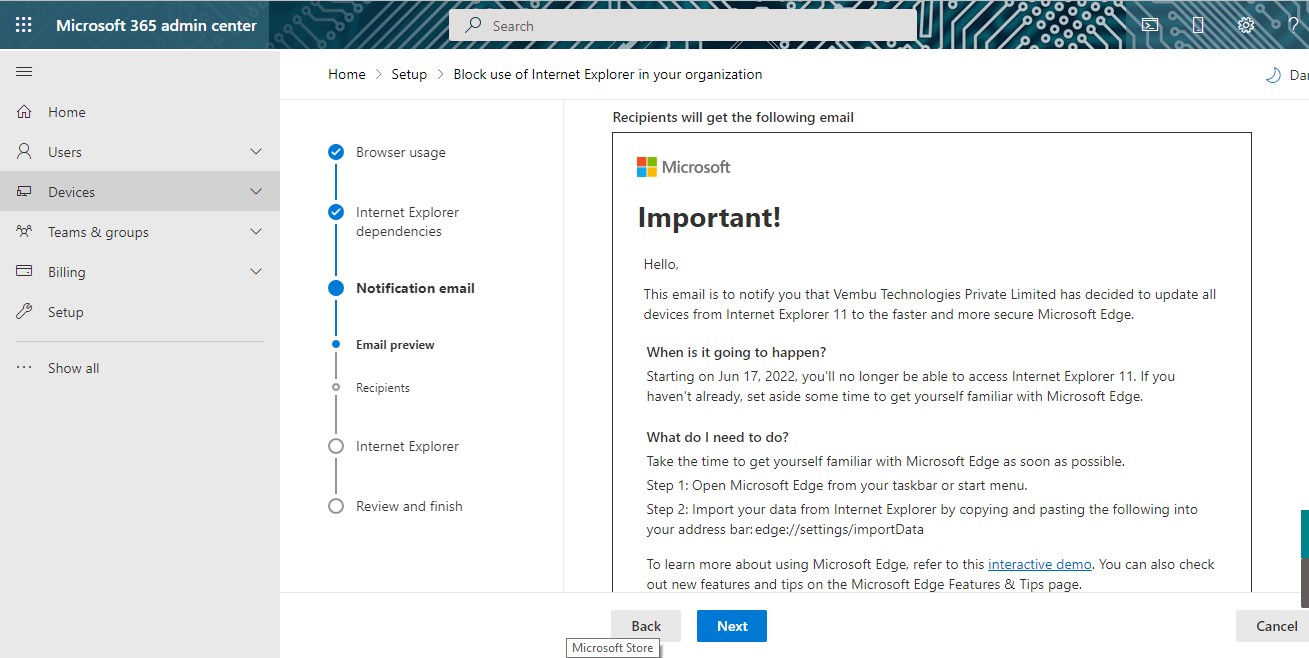
Step 4: Block Internet Explorer
After you configure IE mode, you can block Internet Explorer as a standalone browser without affecting IE mode functionality across your organization using group policy. In this step, we are doing this blocking process through Intune or manually.
When you turn on the “Disable Internet Explorer 11 as a standalone browser policy” setting, all Internet Explorer 11 activity is redirected to Microsoft Edge and users have the following experience:
- The Internet Explorer 11 icon on the Start menu will be removed, but the one on the taskbar will remain
- When users try to launch shortcuts or file associations that use Internet Explorer 11, they will be redirected to open the same file or URL in Microsoft Edge
- When users try to open Internet Explorer 11 by directly opening iexplore.exe, Microsoft Edge will open instead
Click “Next” to review and finish the step. You can review all the settings here once you are satisfied with them. Click Finish.
Now you can see the completed message on the setup screen as shown below.

Microsoft releases a cumulative security update for Internet Explorer 11, infact a Microsoft Edge update yesterday ( Feb 14 2023 )
As per Microsoft,
The retired, out-of-support Internet Explorer 11 desktop application has been permanently disabled through this Microsoft Edge update on certain versions of Windows 10.
Microsoft Edge with IE mode is officially replacing the Internet Explorer 11 desktop application on Windows 10. As a result, the Internet Explorer 11 desktop application will go out of support and be retired on June 15, 2022 for certain versions of Windows 10.
The Microsoft General Information blog says,
The out-of-support Internet Explorer 11 (IE11) desktop application was permanently disabled on certain versions of Windows 10 on February 14, 2023 through a Microsoft Edge update. Note, this update will be rolled out over the span of a few days up to a week, as is standard for Microsoft Edge updates.
All remaining consumer and commercial devices that were not already redirected from IE11 to Microsoft Edge were redirected with the Microsoft Edge update. Users will be unable to reverse the change. Additionally, redirection from IE11 to Microsoft Edge will be included as part of all future Microsoft Edge updates.
IE11 visual references, such as the IE11 icons on the Start Menu and taskbar, will be removed by the June 2023 Windows security update (“B” release) scheduled for June 13, 2023. The optional, non-security preview “C” release on certain Windows 10 versions scheduled for May 23, 2023, will also remove IE11 visual references.
Conclusion:
Since Internet Explorer 11 is out of support, you can make use of setting up a group policy to block Internet Explorer and enable the use of Microsoft Edge as the default browser in a few steps using the Microsoft 365 admin center as described above. It is also easy to disable Internet Explorer using the group policy management console from the domain controller too in your organization.
Follow our Twitter and Facebook feeds for new releases, updates, insightful posts and more.

